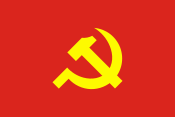More languages
More actions
Communist Party of Vietnam Đảng Cộng-sản Việt-nam | |
|---|---|
 | |
| General Secretary | Nguyễn Phú Trọng |
| Founder | Hồ Chí Minh |
| Founded | 3 February 1930 |
| Newspaper | Nhân Dân |
| Student wing | Vietnamese Students' Association |
| Youth wing | Ho Chi Minh Communist Youth Union Ho Chi Minh Young Pioneer Organization |
| Women's wing | Vietnam Women's Union |
| Political orientation | Marxism–Leninism Ho Chi Minh Thought Socialist-oriented market economy |
| International affiliation | International Meeting of Communist and Workers' Parties |
| Website | |
| en.dangcongsan.vn | |
| Part of a series on |
| Communist parties |
|---|
The Communist Party of Vietnam (Vietnamese: Đảng Cộng sản Việt Nam) is currently the ruling and solely legal political party in Vietnam. It is the vanguard party of the the proletariat, the Vietnamese working class and nation. It was formerly known as the Communist Party of Indochina and the Vietnam Labor Party. The official ideological foundation of the party is Marxism–Leninism and Ho Chi Minh Thought.[1]
History
Background and foundation
Ho Chi Minh founded the Intercolonial Union in 1921 and the Peasants' International Congress in 1923 to oppose French colonialism. Created in 1924, the Vietnam Revolutionary Youth Association was an illegal proletarian organization that agitated workers in mines, factories and plantations. They also worked with peasants and the petty bourgeoisie. In May 1929, they held a congress in Hong Kong and the Bắc Kỳ delegation from northern Vietnam proposed to dissolve the association and form a communist party. This proposal was not accepted, so the Bắc Kỳ delegation left and formed the Indochinese Communist Party. In October, the Nam Kỳ branch of the VRYA from the far south of Vietnam created the Annamese Communist Party. In February 1930, Ho Chi Minh convened a meeting of the the VRYA, ICP, and ACP in Hong Kong, where the three organizations were unified into the Communist Party of Vietnam.[2]
French colonial period
By March 1931, the party had 2,400 members. On 11 April 1931, the Third International recognized the Communist Party of Vietnam. In June, Ho Chi Minh was arrested by the British in Hong Kong but escaped and arrived in the Soviet Union in 1933. Hundreds of revolutionaries were killed by French authorities between 1930 and 1933. The first national congress of the party was held in Macau in March 1935. In July 1935, Lê Hồng Phong was invited to the seventh congress of the Comintern.[3]
Political role
As the sole leading political party in Vietnam, the Communist Party has immense influence on the political, economic, social and cultural life of Vietnam.
Its highest organ is the National Congress consisting of over 1,300 delegates from across the country. This body will then elect the Central Committee. This committee will then elect the Politburo, the Secretariat, the Central Inspection Commission and the General Secretary.
Further reading
References
- ↑ "The Communist Party of Vietnam - the Vanguard of the Vietnamese working class, simultaneously the vanguard of labourers and of the Vietnamese nation, the faithful representative of the interests of the working class, labourers and the whole nation, acting upon the Marxist-Leninist doctrine and Ho Chi Minh's thought, is the leading force of the State and society." Article 4 of the Constitution of the Socialist Republic of Vietnam
- ↑ S. Horrison (1976). An Outline History of the Viet Nam Workers' Party (1930–1975): 'The struggle to set up the Party of the Vietnamese working class. The August 1945 Revolution and the founding of the Democratic Republic of Viet Nam (1920-1945).' (pp. 7–14). [PDF] Hanoi: Foreign Languages Publishing House.
- ↑ Foreign Languages Publishing House (1986). History of the Communist Party of Vietnam (pp. 38–48). [PDF] Hanoi.
